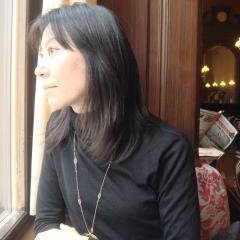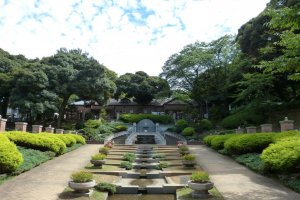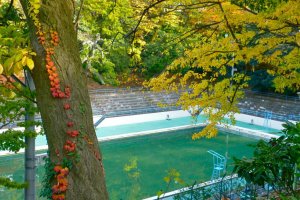If you happen to come across the remains of this interesting waterworks in Motomachi, within Motomachi-koen Park, you will be so curious that you won’t be able to ignore it. In the middle of a residential area, you suddenly see an old pond. The pond is divided into sections by old red bricks, and there is a walkway in the center of the pond with metal handrails. What on earth is this? What was it for? These BIG questions kept coming into my mind and so I decided to investigate.
Water business
After 200 years of isolation, Japan finally opened her doors to the rest of the world by opening the port at Yokohama in 1859. Once trading started, it flourished very quickly. And soon huge numbers of foreign ships were coming in and out of the port day after day.
The biggest market was silk and green tea. Many traders made large profits and their followers built merchant offices in the Kannai area (officially opened for foreigners) in rapid succession. Foreign retailers who also came to Japan for business, quickly found ways to fulfill all the needs of the traders’ daily lives. Banks, restaurants, bakeries, grocers, liquor shops, cleaning shops, and all other stores were built step by step. But the most important thing for life here was not so easy to get. WATER. Kannai was a newly constructed landfill and the water from most wells was mixed with seawater. Some Japanese started to sell spring water in Kannai. Seeing this, one French businessman directed his attention to the water supply business.
Alfred Gerard’s waterworks
Alfred Gerard was born in Reims, France in 1837 and came to Japan around 1863, when he was 24. This was very soon after Yokohama had been opened. At first, he started business as a meat and liquor seller. In 1867 the government put 200 sections of land up for auction in Yamate hills and Gerard got a place with a good water source. He designed and constructed two water tanks for filtration and set up pipes between his office and the nearest river. Water was transferred to anchoring ships (his biggest customers) on smaller ships by way of the river. Gerard’s water was also supplied to the Kannai business town and the Yamate residential areas. His water was of high quality and had an excellent reputation among sailors. It was said that Gerard’s water wouldn’t go bad all the way to the Indian Ocean. His business was officially registered in 1868 as a water supplier. Japanese people called his water factory “Mizu-yashiki (water house).”
Tile and brick works
After the huge success of his water business, Gerard came up with a new idea in 1873. Due to the increasing demand of construction by Western residents and businesses, he realized that western-style tiles and bricks would be a big market. He soon built a tile and brick factory that was driven by steam. It grew quickly and he was a big success again.
Motomachi-koen Park
Although Gerard’s filtration tanks were covered by a roof, they are uncovered now. You can see the brick-made water reservoir from above; colorful carp swim about in it!
Walk along for a few more minutes, and you reach a park with well-trimmed trees and flowers. This was the location of his brick and tile factory. At the far end of the park there is a red brick building, which is the entranceway to a modern day outdoor public swimming pool. In 1930, local organizations built this pool using spring water from the old Gerard Factory. A few of the roof tiles are still old Gerard’s tiles.
Gerard’s life after Japan
In 1878 Gerard returned to France for good. He needed a few years rest and treatment in the Vichy hot springs, on the urban fringe of Paris. Then he settled down at Reims and started life anew. Surrounded by old friends, he planed the later half of his life. During his long stay in Japan, he had acquired quite a collection of Japanese curios, arts and crafts. He generously donated to Reims city 2400 items from his collection without any ounce of vanity. He just said, “I dedicate these collections to people who appreciate that handmade articles are really beautiful.” Later all the collections were stored at the Saint Remi Museum. In addition, he had collected 25,000 books mainly concerned with agriculture and science, and with them opened a large public library in Reims. He also established an agricultural circle for farming education, and invented a clever double-deck tank for excreta. He died in 1915 and was buried in Bezannes according to the dictates of his will. A stone shrine gate, one stone lantern on the right, and two stone lanterns on the left decorate his grave. It sounds a bit strange to me, but I can feel his admiration and adoration for Japan
Access
From Exit 5 Motomachi-Chukagai Station of the Minato-mirai line, turn left and walk straight until you see a GAP clothing shop. At the first intersection after GAP, turn left. You are on Mizu-yashiki Street. Go straight up this gentle slope for a few minutes and you will see the remains of the Gerard Waterworks on the left. As you go further up the slope you will discover more of his footsteps.
































